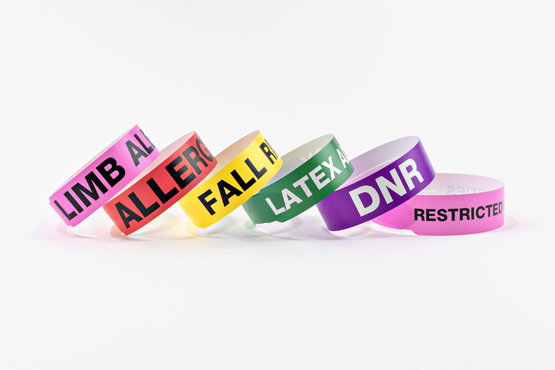The Purpose of Patient Identification Band in Optimizing Hospital Operations
The Purpose of Patient Identification Band in Optimizing Hospital Operations
Blog Article
Checking Out the Numerous Sorts Of Patient Identification Band Made Use Of in Clinical Facilities
In the intricate world of health care, the crucial function of Patient Identification bands usually goes unnoticed. These bands, differing from basic paper wristbands to innovative RFID bands, develop the foundation of Patient safety and security methods, making certain precision in Patient Identification.
Comprehending the Significance of Patient Identification Bands
While they might appear like mere devices, Patient Identification bands play a vital role in clinical centers. These bands offer as a crucial device for confirming Patient identification, protecting against clinical mistakes related to misidentification. Patient Identification bands also aid in enhancing management tasks, ensuring precise record-keeping and payment.
Typical Paper Wristbands: Their Usage and Limitations
Standard paper wristbands have actually been a staple in Patient Identification across various clinical centers. While their usage prevails, they harbor particular constraints that might influence their performance in Patient administration. This area will certainly focus on the scope of their application and the inherent downsides connected with their use.
Paper Wristbands: Use Range
In the world of Patient Identification, paper wristbands have long held a crucial role. These bands are typically utilized in outpatient settings, where the Patient's remain is temporary. Despite improvements in innovation, the humble paper wristband stays a affordable and trustworthy option for Patient Identification in various healthcare circumstances.
Limitations of Paper Wristbands
In spite of their extensive use, paper wristbands are not without their drawbacks. In enhancement, paper wristbands frequently do not have the technical abilities of more contemporary alternatives, such as barcoding or RFID chips, restricting their capability to simply presenting created information. Paper wristbands can cause pain or skin irritability to some patients, particularly when worn for prolonged durations.
Barcoded Wristbands: Developments in Patient Identification
While Patient Identification has long been a vital aspect of health care, the development of barcoded wristbands signifies a substantial jump ahead. These bands leverage the simpleness of barcoding innovation, allowing for Patient details to be swiftly scanned and accessed. They improve the rate and accuracy of Patient Identification, lowering the risk of clinical mistakes related to misidentification. Barcoded wristbands are cost-efficient, very easy to generate, and get rid of handwriting mistakes common with hand-operated systems. However, they are not without constraints. While they provide renovations over typical bands, the barcode can come to be used or smudged, rendering it unreadable. Despite this, barcoded wristbands continue to be a necessary tool in modern health care settings, signifying the intersection of technology and Patient care.
Superhigh Frequency Identification (RFID) Bands: an Action Towards Futuristic Medical Care
The evolution of Patient Identification bands has actually produced the appearance of Radio Regularity Identification (RFID) Bands (patient identification band). These innovative tools here existing vital benefits for health care centers, supplying an extra efficient and highly advanced methods of Patient Identification. The implementation of RFID in health care is a substantial action towards a much more advanced strategy to Patient management and security
Comprehending RFID Bands

RFID Bands: Secret Benefits
Largely, these bands enhance Patient safety and security by offering exact, instantaneous Identification, thus reducing clinical errors. RFID bands can store a huge amount of Patient data, consisting of clinical history and allergic reactions, making it possible for customized treatment. Overall, RFID bands represent a considerable innovation in Patient Identification modern technology, profiting both clients and health care companies.
Applying RFID in Medical Care
These bands offer a smooth method to track and recognize individuals, guaranteeing their safety and improving efficiency in therapy procedures. RFID bands lower clinical errors by providing accurate Patient Identification, which is essential in stopping misdiagnosis or incorrect medicine administration. Hence, the execution of RFID bands is a substantial action in the direction of boosting Patient safety and security and healthcare delivery.

Color-Coded Wristbands: Assisting in Quick and Accurate Medical Diagnosis
In the busy setting of a medical facility, color-coded wristbands have actually become important devices for swift and exact Identification of a person's medical problem. These wristbands, put on by people, bring particular colors that match to various clinical problems or statuses. As an example, red could suggest allergy threats, while yellow might signify a loss danger. This system is made to offer instant aesthetic signs to doctor, enhancing Patient safety and care high quality. In emergency situation situations, using these wristbands enables fast decision-making. The efficiency of color-coded wristbands depends on the uniformity of shade analysis across healthcare organizations, calling for common requirements for regular application.
Strategies for Reliable Execution and Monitoring of Patient ID Bands
Achieving optimal usage of Patient Identification bands demands a well-structured method for their application and monitoring. Patient education and learning is also crucial; clients have to comprehend the function of the bands and the need for their continuous wear. It's necessary to have a back-up strategy in location, such as barcode scanning or biometrics, to guarantee that Patient Identification is never endangered.
Conclusion
Patient Identification bands are vital in clinical facilities to ensure safety and security and precision. Efficient execution and management of these bands can considerably reduce medical mistakes, enhance performance, and boost total Patient treatment.
These bands, differing from simple paper wristbands to innovative RFID bands, create the foundation of Patient safety procedures, guaranteeing accuracy in Patient Identification.The advancement of Patient Identification bands has check here brought about the development of Radio Frequency Identification (RFID) Bands. In general, RFID bands represent a substantial innovation in Patient Identification innovation, benefiting both individuals and medical care service providers.
RFID bands reduce medical mistakes by giving accurate Patient Identification, which is essential in preventing misdiagnosis or wrong medicine administration. Patient education and learning is likewise essential; people should recognize the objective of the bands and the demand for their constant wear.
Report this page